10 of the Best Flowering Ground Cover Plants
Most flowering ground cover plants spread quickly and are easy to care for. A DIY addition of colorful ground covers to your rock garden or beneath a tree is an easy feat for even the non-gardener.
Our 16 Favorite Flowering Ground Covers
Although ground covers are typically grown for their dense, fast-spreading foliage, many also put on a breathtaking display of flowers, with some giving you blooms for weeks on end. Shade-loving flowering ground covers, such as Epimedium (barrenwort) or Pachysandra, are invaluable for bringing masses of color to woodland gardens or as understory plantings beneath trees and shrubs. For sun-drenched bare spots in the garden or to blanket areas where grass struggles to grow, try mat-forming creeping bloomers like Sedum or Phlox subulata (creeping phlox).
Note that while most of these ground cover flowers are well-behaved and easy to keep in check, some can spread aggressively and become invasive when planted in certain areas. Lamium (deadnettle), Ajuga (bugleweed), and Galium odoratum (sweet woodruff) are examples of varieties best reserved for locations where you can easily control their spread. Before buying and planting any ground cover, refer to the Invasive Plant Atlas to see if the plant could be invasive in your area.
On this page:
GROUND COVER FLOWERS FOR SHADE

Photo by: Mizy / Shutterstock
BARRENWORT (Epimedium spp. and cultivars)
Zones: 5-9 Exposure: Partial to full shade
Height/Spread: 8 to 12 inches tall, spreading 12 to 36 inches
Bloom time: Early to mid-spring
Valued as a ground cover for dry shade, barrenwort (also known as bishop’s hat) has pretty heart-shaped leaves and delicate, nodding flowers in shades of pink, red, violet, or yellow. Red barrenwort (E. x rubrum) is an especially showy plant, with bright crimson blooms and semi-evergreen foliage accented by tinges of red in both spring and fall. It also spreads faster than most epimediums, making it one of the best ground cover species.

‘Burgundy Glow’ bugleweed. Photo by: Walters Gardens, Inc.
BUGLEWEED (Ajuga reptans)
Zones: 3-10 Exposure: Partial shade to full sun
Height/Spread: 6 to 8 inches tall, spreads to 2 feet or more
Bloom time: Late spring through early summer
This resilient perennial spreads quickly to form a dense mat that will help smother weeds, but avoid growing it in a spot where its aggressive nature could infringe on other plantings. Although the species usually has violet-blue flower spikes and glossy, dark green leaves, a number of cultivars are available that offer variegated or dark burgundy foliage and pink or white blooms.

‘Cutting Edge’ foamflower. Photo by: Proven Winners
FOAMFLOWER (Tiarella)
Zones: 4-9 Exposure: Partial to full shade
Height/Spread: 8 to 10 inches tall, 16 to 19 inches wide
Bloom time: Late spring through early summer
Prized for its frothy flowers that bloom over an exceptionally long time, foamflower also boasts deeply lobed, patterned leaves that remain evergreen in most climates. Although Tiarella are better for deep shade than their cousin Heuchera, they grow best in the dappled sunlight of woodland gardens. Learn more about growing foamflower.
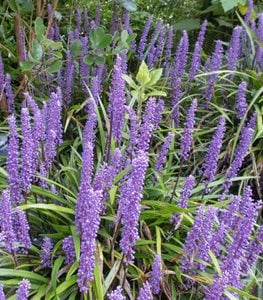
Photo by: Peter Turner Photography / Shutterstock
LILYTURF (Liriope muscari)
Zones: 5-10 Exposure: Full shade to full sun
Height/Spread: 12 to 18 inches tall, spreads up to 12 inches
Bloom time: Late summer to fall
Often mistaken for an ornamental grass because of its narrow, arching leaves, Liriope is primarily prized for its showy spikes of purple flowers and ability to thrive in both shady and sunny garden sites. Tolerant of drought and most soil types, its applications are many, ranging from a ground cover in woodland gardens to erosion control on slopes.

Photo by: Gerry Bishop / Shutterstock
PACHYSANDRA (Pachysandra spp.)
Zones: 5-9 Exposure: Partial to full shade
Height/Spread: 6 to 12 inches tall, spreads 12 to 18 inches
Bloom time: Spring
One of the best flowering ground covers for deep shade, forming a lush carpet of glossy, emerald-green foliage topped by short spikes of white flowers in early spring. Although Japanese pachysandra (P. terminalis) is the most commonly grown variety, it can spread aggressively once it becomes established. A better behaved alternative is Allegheny spurge (P. procumbens) (pictured), a slow-growing native American species with blue-green leaves that turn bronze in fall.

Proven Accents® Pink Chablis® dead nettle. Photo by Proven Winners.
SPOTTED DEADNETTLE (Lamium maculatum)
‘Pink Chablis’ spotted deadnettle — Buy now from Proven Winners
Zones: 4-9 Exposure: Partial shade to full sun
Height/Spread: 3 inches to 2 feet tall, spreads 3 feet or more
Bloom time: Late spring to early summer
A versatile ground cover adaptable to a wide range of growing conditions and most soil types. Scalloped leaves come in a variety of color variations and remain attractive all season, while the colorful flower spikes (in pink, white, rose, or violet) bloom for 4 weeks or longer, starting in late spring. Because of their creeping, rooting habit, you should only plant Lamium in areas where they won’t wander out of bounds.

Bildagentur Zoonar GmbH /Shutterstock
SWEET WOODRUFF (Galium odoratum)
Zones: 4-8 Exposure: Partial to full shade
Height/Spread: 6 to 12 inches tall, spreads 12 to 18 inches
Bloom time: Early spring
Bearing clusters of tiny white flowers in spring, this enchanting ground cover loves heavy shade and rich, loamy soil, making it a top performer in woodland gardens. Can become somewhat aggressive if given the right conditions, so plant where you can limit its growth.
GROUND COVER FLOWERS FOR SUN

Photo by: Peter Turner Photography / Shutterstock
BASKET OF GOLD (Aurinia saxatilis)
Zones: 4-7 Exposure: Full sun
Height/Spread: 6 to 12 inches tall, spreads up to 2 feet
Bloom time: Early to mid-spring
In addition to brightening the spring garden with dense clusters of golden-yellow flowers, Aurinia has handsome silvery gray foliage make it an asset even when it’s not in bloom. After the blooms fade, shear back by about half to help shape the plant and improve its vigor. Requires ample sunlight and well-draining soil to thrive.

Snowsation™ candytuft. Photo by: Proven Winners
CANDYTUFT (Iberis sempervirens)
Zones: 4-9 Exposure: Full sun
Height/Spread: 6 to 8 inches tall, spreads up to 12 inches
Bloom time: Mid to late spring
This spring-blooming favorite produces a profusion of snowy white flowers that nearly hide the plant’s attractive mounds of glossy, evergreen foliage. The sweetly scented blooms can last a month or longer, and may even return for a short repeat performance in fall. To encourage denser foliage growth, prune back lightly in late spring after the flowers fade.

‘Rapido Blue’ Carpathian bellflower. Photo by: Proven Winners
CARPATHIAN BELLFLOWER (Campanula carpatica)
Zones: 3-8 Exposure: Full sun to partial shade
Height/Spread: 5 to 7 inches tall, 5 to 8 inches wide
Bloom time: Early spring to summer
This long-blooming, easy-to-grow perennial creates a colorful carpet of violet-blue flowers that last through most of the summer, rising above tidy mounds of dark green foliage. Especially well-suited as a ground cover in rock gardens, borders, and mass plantings. For the best performance, grow in fertile, well-drained soil and shelter from harsh afternoon sun.
![]()
‘Purple Sprite’ spring phlox. Photo by: Proven Winners
CREEPING PHLOX (Phlox subulata)
‘Purple Sprite’ spring phlox — Buy now from Proven Winners
Zones: 3-9 Exposure: Full sun
Height/Spread: 4 to 6 inches tall, spreads 18 to 24 inches
Bloom time: Early to mid-spring
Unlike taller garden phlox, this ground-hugging variety (also called moss phlox) grows to a height of only 6 inches, smothered in spring by cheery flowers in shades of lavender, pink, rose, or purple. Once the blooms fade, they leave behind an attractive mat of needle-like foliage. A light shearing after flowering will encourage lush new growth and prevent plants from becoming leggy.

Red creeping thyme. Photo by: Proven Winners
CREEPING THYME (Thymus spp.)
Coccineus red creeping thyme — Buy now from Proven Winners
Zones: 4-10 Exposure: Full sun
Height/Spread: 1 to 4 inches tall, spreads up to 18 inches
Bloom time: Late spring to early summer
Highly resilient to foot traffic, this low-growing aromatic herb is ideal for use as a filler between stepping stones and pathways or as an easy-care lawn substitute. Not only does this drought-tolerant perennial require less water than traditional turf grass, it’s also much more colorful, bursting into a profusion of dainty pink or purple flowers in late spring. Learn more about growing creeping thyme.

Georgia Blue creeping speedwell. Photo by: Maria Papworth / Shutterstock
GEORGIA BLUE CREEPING SPEEDWELL (Veronica peduncularis ‘Georgia Blue’)
Zones: 6-8 Exposure: Full sun
Height/Spread: 6 to 8 inches tall, spreads up to 18 inches
Bloom time: Early to late spring, reblooming intermittently throughout the summer
Striking sapphire blue flowers with white eyes make this ground cover a real standout in the spring garden and a colorful underplanting for spring-blooming bulbs. To keep plants tidy and encourage rebloom, shear back by about half after flowering. Otherwise, this heat- and drought-tolerant bloomer requires minimal care once established. Learn more about growing speedwell plants.
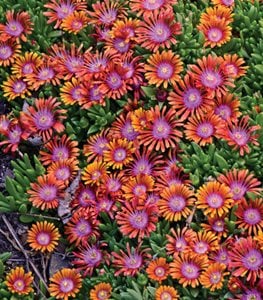
Fire Spinner ® hardy ice plant. Photo by: Proven Winners
HARDY ICE PLANT (Delosperma cooperi)
Fire Spinner ® hardy ice plant — Buy now from Proven Winners
Zones: 6-10 Exposure: Full sun
Height/Spread: 3 to 6 inches tall, spreads up to 2 feet
Bloom time: Early summer to fall
Brightly colored, daisylike flowers over a long bloom season make hardy ice plant a valuable ground cover for filling the garden with brilliant color that lasts all the way until fall. The fleshy, cylindrical leaves are also an asset, forming a shaggy succulent carpet that remains evergreen in milder climates. Requires well-draining soil to flourish, especially in areas with damp, rainy winters.

Photo by: Ball Horticulture Company
LADY’S MANTLE (Alchemilla mollis)
Zones: 3-9 Exposure: Full sun to partial shade
Height/Spread: 12 to 18 inches tall, spreads 1 to 2 feet
Bloom time: Early to mid-summer
Airy clusters of lime-green flowers, rising above mounds of broad scallop-edged leaves, make Alchemilla a striking ground cover, both in and out of bloom After the flowers fade, cut plants back to promote fresh foliage growth that will remain attractive the rest of the season. Adapts well to light and even moderate shade, but won’t tolerate dry conditions in climates with hot summers.
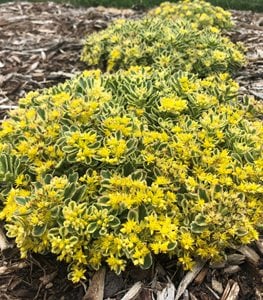
Rock ‘N Low® ‘Boogie Woogie’ stonecrop. Photo by: Proven Winners
SEDUM (Sedum hybrids)
Rock ‘N Low® ‘Boogie Woogie’ stonecrop — Buy now from Proven Winners
Zones: 3-9 Exposure: Full sun to partial shade
Height/Spread: 6 to 8 inches tall, spreads up to 2 feet
Bloom time: Early to mid-summer
Creeping Sedum (also known as stonecrop) is a tough mat-forming ground cover that thrives in dry sites thanks to its thick, succulent leaves that store water and help it cope with drought. Although the leaves can vary greatly in color and shape, the flowers of most varieties are tiny and star-shaped, blooming in shades of pink, red, white, or yellow. An excellent plant for rock gardens, filling gaps between paving stones, or erosion control on sunny slopes and hillsides. Learn more about growing sedum plants.
10 of the Best Flowering Ground Cover Plants

Flowering ground covers are the most useful tools in landscape design. They’re low-maintenance, drought-tolerant, and multi-functional, and they bring eye-popping curb appeal when in bloom.
Do you have a hilly area in your yard that’s difficult to mow? Unsightly roots that you’d like to cover? A driveway in need of an attractive border? Flowering ground covers can solve all these problems and look beautiful while doing it. Here are 10 of the best flowering ground cover plants for your garden or landscape.
Landscaping and more at the click of a button
1. Ice Plant (Delosperma)

Delosperma refers to a genus of more than 100 different species of succulent plants. Delosperma cooperi, also known as Cooper’s ice plant, is a mat-forming evergreen with big purple flowers that bloom from early summer to fall. The vibrant color and long blooming season of the ice plant makes it a top choice for bold garden color.
USDA Hardiness Zones: 6 to 10
Examples of Delosperma varieties: Fire spinner, jewel of the desert, kelaidis, wheels of wonder
Care: Easy to grow. Thrives in full sun but requires dry, well-draining soil to flourish.
Flowering: Ice plants produce large, deep purple, daisy-like flowers from early summer to fall.
Spread: Via seed
Cost: Seeds cost about $5 for 500. You’ll pay up to $10 for a plant tray, and about $125 for 25 container plants.
2. Lilyturf (Liriope)

Sometimes referred to as monkey grass, this flowering perennial is ultra-tough. The plant itself is tall and grass-like so it works well as an edging plant or to prevent erosion. Liriope flowers in the late summer and will produce tall shoots with lavender flower spikes.
USDA Hardiness Zones: 4 to 10
Examples of Liriope varieties: Liriope spicata and liriope muscari
Care: Low-maintenance and highly drought-tolerant. Handles both full sun and partial shade. Requires medium to well-draining soil
Flowering: Tall flowers of vibrant lavender to white bloom late summer to early fall
Spread: Spreads vigorously via creeping rhizomes and can be considered invasive in certain regions
Cost: Ranges from about $7 for five seeds to almost $120 for a 54-count tray.
3. Canada Anemone (Anemone canadensis)

Canada anemone is a hardy, low-growing ground cover plant that produces showy white flowers from April through June. Also known as meadow anemone or roundleaf thimbleweed, this perennial wildflower looks great, can handle some foot traffic, and grows easily.
Note: This plant is aggressive, so it should quickly become a beautiful green mat with spectacular white blooms.
USDA Hardiness Zones: 3 to 8
Care: Canada anemone can handle both full sun and partial shade. Prefers medium to medium wet soil conditions but may need pruning because of its aggressive nature.
Flowering: Each tall stalk produces one bright white flower with five petals and a yellow center. Flowers April through June.
Spread: Spreads vigorously via rhizomes. Can reseed itself under the right conditions
Cost: Seeds cost $3 for a packet of 200, 3-inch pots run $4 to $7 each.
4. Creeping Thyme (Thymus serpyllum)
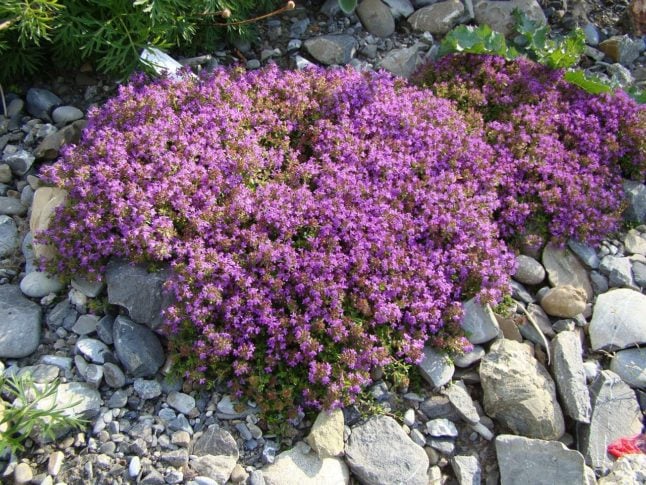
“Creeping thyme” is the common name for a group of several perennial ground cover plants of the thymus genus. These low-growers thrive in full sun and are an attractive choice for sunny gardens thanks to their low, vine-like growth habit and beautiful flowers. While these varieties aren’t as tasty as the thyme in your spice rack, they are pleasantly aromatic.
USDA Hardiness Zones: 4 to 9 (depending on variety)
Examples of ground cover thyme plants: English thyme, caraway thyme, wooly thyme
Care: These low-maintenance plants need full sun and well-draining soil
Flowering: Creeping thyme produces large blooms of purple, pink, or white flowers from late spring to mid-summer
Spread: All thyme plants spread by above-ground stems, but varieties will range from slow to moderate to fast spreaders
Cost: A pack of 5,000 seeds costs about $5 online, container plants run about $40
5. Creeping Phlox (Phlox subulata)

Creeping phlox is a sun-loving and drought-resistant ground cover plant that generates a carpet of color in the spring. It works well as ground cover throughout most of the year, but its abundant springtime blooms are the star of the creeping phlox show.
USDA Hardiness Zones: 3 to 10
Examples of creeping phlox varieties: scarlet flame, candy stripe, emerald blue, phlox volcano
Care: Low-maintenance, but requires rich and well-drained soil. You’ll want to trim plants back in the winter
Flowering: Dense, springtime blooms of purple, red, white, blue, rose, lavender, or pink flowers
Spread: Moderate spread of up to 2 feet, by way of stolons
Cost: From $4 (seed packet) to $10 (trays) to $14 (potted)
Get quality landscaping at an affordable cost
6. Bugleweed (Ajuga reptans)

Bugleweed is a quick-spreader that works well covering areas where grass struggles. It’s versatile and can handle most conditions, thriving in everything from full sun to full shade and heavy foot traffic. It also doesn’t hurt that it brings added curb appeal with its attractive blue flower spikes that bloom from May through June.
USDA Hardiness Zones: 3 to 10
Examples of bugleweed varieties: black scallop, burgundy glow, pink beauty, catlin’s giant
Care: These are low-maintenance in large areas but will require some diligence to control in smaller areas. Runners should be pruned twice a year and as needed when escaping their desired planting area
Flowering: Violet, purple, or blue flower spikes in the mid to late spring
Spread: Spreads aggressively via runners, making it best used to fill large areas
Cost: Seeds range based on quantity from $4 to $400. A tray of these fast-spreading plants costs about $12
7. Spotted Deadnettle (Lamium maculatum)

Easy to grow and tolerant of most soil conditions, spotted deadnettles are great perennial ground covers for shaded areas. These low-growing plants are resilient and can even be evergreen in warmer climates. Their green leaves are typically variegated and attractive on their own, but their abundant flowers are a beautiful addition in the late spring to early summer. Deadnettles are aggressive spreaders that can become invasive if not controlled.
USDA Hardiness Zones: 3 to 8
Examples of deadnettle varieties: Anne greenway, purple dragon, shell pink, beacon silver, orchid frost
Care: Drought-tolerant, grows best in shade, should be cut back after flowering to encourage fresh foliage growth. Dislikes high heat and humidity
Flowering: Pink, purple, and white flowers (depending on cultivar) from May to June
Spread: Spreads aggressively. Can be considered invasive in some areas.
Cost: Ranges in price from $6 to almost $20
8. Lamb’s Ear (Stachys byzantina)
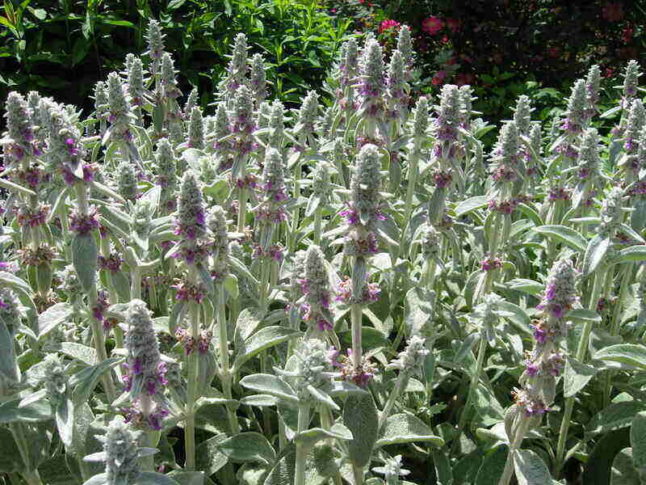
Lamb’s ear is a sun-loving ground cover plant known for its velvety look and feel of its namesake foliage. Lamb’s ear is a vigorous perennial that spreads quickly and develops a low mat of leaves. As an added bonus, lamb’s ear produces spikes of purplish flowers up to 18 inches tall in the summer.
USDA Hardiness Zones: 4 to 7
Examples of lamb’s ear cultivars: big ears, silver carpet, Helen von stein, cotton boll
Care: Low-maintenance. Water only when soil is dry and trim back in the spring.
Flowering: Tall, light-purple flower spikes bloom in the summer
Spread: Spread aggressively through creeping stems and self-seeding. Deadheading can reduce spread by self-seeding
Cost: About $5 for a 1-quart pot, or a pack of 40 seeds for less than $10
9. Periwinkle (Vinca minor)
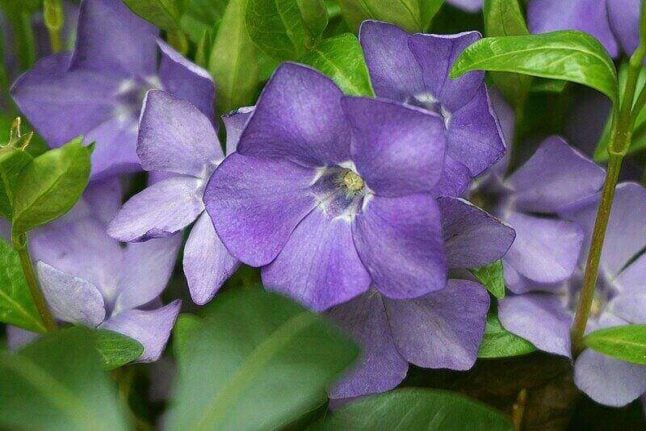
This tough, low-maintenance ground cover plant is an evergreen perennial that can handle full shade and partial sun. Also known as vinca minor, its vines keep it low to the ground. Both the broadleaf foliage and abundant flowers of the periwinkle make it an attractive choice for steep hillsides that are difficult to maintain. It also works well in areas where grass won’t grow.
USDA Hardiness Zones: 4 to 8
Examples of periwinkle varieties: alba, flore pleno, sterling silver, bowles variety
Care: Requires minimal care, though they may require some trimming to avoid invasive spread. Can be susceptible to disease in wet, humid climates
Flowering: Blue, lavender, white, or purple flower show in May, June, and sometimes the fall
Spread: Aggressively via above-ground runners. Can be invasive if left unchecked.
Cost: A tray of periwinkle typically costs about $15.
10. Sweet woodruff (Galium odoratum)

Sweet woodruff, named after the sweet smell of its deep green foliage, is an excellent ground cover plant for shady gardens. This mat-forming creeper prefers moist soil, but can tolerate drought and will even thrive in dry shade. It’s an extremely low-maintenance perennial that only requires care when you want to limit its growth.
USDA Hardiness Zones: 4 to 8
Care: Very low-maintenance. Thrives in most conditions. Runners may need occasional trimming to limit growth
Flowering: Blooms with white, star-shaped flowers in April and May
Spread: Spreads quickly by runners.
Cost: Get 200 seeds for $7 or a large, potted plant for under $20.
FAQs About Flowering Ground Cover Plants
What are the fastest-growing ground cover plants?
Many varieties of ground covers, including many of those listed above, are notoriously fast-growers. Some can be invasive and are only recommended if you don’t mind them taking over the area where you plant them. Spotted deadnettle, lamb’s ear, periwinkle, and sweet woodruff are some of the fastest-growing varieties.
What ground cover plants will prevent weeds?
Most ground covers help prevent weeds because of the way they spread out and fill up spaces. Dragon’s blood sedum is one of the best because of its hardiness and tolerance to poor soil conditions.
Is lavender a good ground cover plant?
Lavender has a pleasant smell and attractive bloom, and even though it’s a perennial, it is a high-maintenance ground cover. It does well in hot, dry areas but is slower to grow and spread than other ground cover plants.
When to Call a Landscaping Professional
Most flowering ground cover plants spread quickly and are easy to care for. A DIY addition of colorful ground covers to your rock garden or beneath a tree is an easy feat for even the non-gardener.
But what if you need to cover a large area, while preventing uncontrolled spread, in a fickle soil? If things get a bit complex, or you simply want the expert eye of a landscape designer, contact a landscaping pro near you.
Order top-notch landscaping service with easy online booking
Main Photo Credit: Pxhere